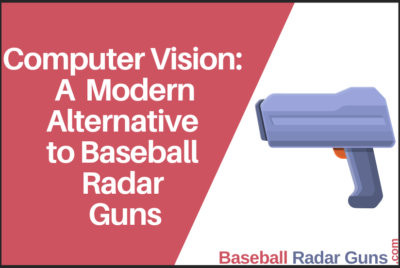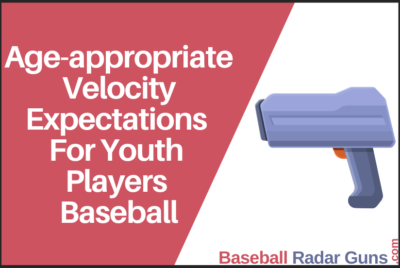Youth Baseball Training: When to Introduce Radar Guns
*We may earn a commission for purchases made using our links. Please see our disclosure to learn more.
Since the acceptance of radar guns as standard equipment in Baseball, it has become one of the most useful tools for training youth baseball players. Radar guns can help players develop their skills by providing an accurate readout of their pitch velocity and accuracy. It is a valuable tool for coaches and players looking to increase their training and performance in Baseball. Radar guns measure the speed of a pitch, allowing players to track their performance and make adjustments as necessary.
However, a safe introduction of radar guns is important when it comes to youth baseball training. Timing and effective use of the device is crucial to proper implementation during training. Otherwise, the result may not be as positive as the coaches or trainers wanted. So, what factors do you need to consider when introducing radar guns for youth baseball training? These can inform when to start using the handy devices. Learn about the factors and more in this article. Enjoy reading.
Table of Contents
What is youth baseball training, and what does it entail?
As a parent of a young baseball player, you want to ensure that your child is getting the best training possible to give them an edge on the field. Youth baseball training is an important factor in the development of any young player and can help them reach their full potential.
So, what should an ideal youth baseball training focus on?
Youth baseball training should focus on building fundamental skills such as hitting, throwing, fielding, and base running. By mastering these skills, players can become more confident and comfortable on the field. In addition to the fundamentals, youth baseball training should also include strength and conditioning, as well as mental and emotional development. Learn more about the skills below:
Hitting
This is one of the most important skills in the game of Baseball and should be a focus of any youth baseball training program. Hitting drills should be done on a regular basis in order to help players develop proper form, develop a quick and powerful swing, and become comfortable with the different pitches.
Throwing
Here is another fundamental skill that must be developed in order for a player to be successful on the field. Proper throwing form should be taught, and drills should be done to help players gain arm strength and accuracy.
Fielding
Fielding is another important part of youth baseball training. Fielding drills should be done on a regular basis to help players develop their footwork, glove work, and throwing accuracy.
Base Running
This skill is often overlooked in youth baseball training. However, it is important for players to understand the importance of proper running form and how to steal a base.
Strength and conditioning
These are also important parts of youth baseball training. Players should be doing exercises to improve their overall strength and endurance. This can help players become faster, stronger, and more explosive.
Mental and emotional development
Players should be taught how to stay focused and positive in the face of adversity. They should also be taught the importance of teamwork and how to communicate effectively with their teammates.
Factors to consider when introducing radar guns in youth baseball training
It is important to introduce radar guns into baseball training at the appropriate time. Generally, radar guns should not be used until players have mastered the fundamentals of pitching, such as proper arm and body mechanics, as well as basic pitching techniques.
Once these fundamentals have been established, players can begin to use radar guns to track their progress and measure their velocity. This can help players identify areas where they need to improve and make the necessary adjustments to increase their performance.
Furthermore, when it comes to using radar guns in practice, coaches should ensure that they are using the technology to supplement, rather than replace, traditional methods of teaching. Coaches should use the radar readings as an additional tool to evaluate the performance of pitchers, but they should not rely solely on the data to make decisions.
Below are key factors to consider when introducing radar guns in youth baseball training:
Player’s age
The first thing to consider is the age of the players. Most experts agree that radar guns should not be used for players under the age of 12. Young players should focus on developing the fundamentals of pitching and learning proper mechanics. Radar guns are best used for players who are 14 and older, as at this age, they are more likely to understand the concept and be able to use the data to their advantage.
Type of drill
Another important factor to consider is the type of drills that are being used. Radar guns should not be used for drills that focus solely on speed, such as the “timed pitch” drill. Instead, they should be used to measure the speed of pitches during game-like scenarios, such as pitch counts or live at-bats. This is important for teaching pitch command, which is an essential skill for any pitcher.
The mental and emotional impact
Coaches should consider the mental and emotional impact that the use of radar guns can have on young players. If a pitcher consistently records low speeds, it can be discouraging and may lead to frustration. Coaches should ensure that all players understand the purpose of the radar gun and emphasize the importance of developing technique rather than simply trying to throw as hard as possible.
Proper handling and use
When introducing radar guns, it is important to ensure that the players are using them properly. It is important to explain to the players how the gun works and the information it can provide. This will help them understand the tool’s value and how to use it correctly. Additionally, it is important to explain to the players that the radar gun is not a substitute for proper technique and form. The gun should simply be used as a tool to help them improve their pitching skills.
How to Best Use Radar Guns
It is important to use the device properly to maximize the benefits of using a radar gun. Players and coaches should be aware of the limitations of the device and use it to measure pitch velocity, not as a substitute for proper pitching mechanics. Additionally, it is important to use the device in a controlled environment and to provide players with adequate feedback on their performance.
Conclusion
Radar guns can be a valuable tool for coaches and players looking to improve their performance in Baseball. By introducing radar guns into training at the appropriate time, coaches and players can use the device to accurately measure pitch velocity and identify areas of improvement. However, ensure that you consider age, type of drill, mental and emotional impact, and handling of the device before introducing radar guns in youth baseball training. This will help avoid over-dependent on the device and its wrong use. Here’s my guide to the best 2023 baseball radar guns for any budget.




